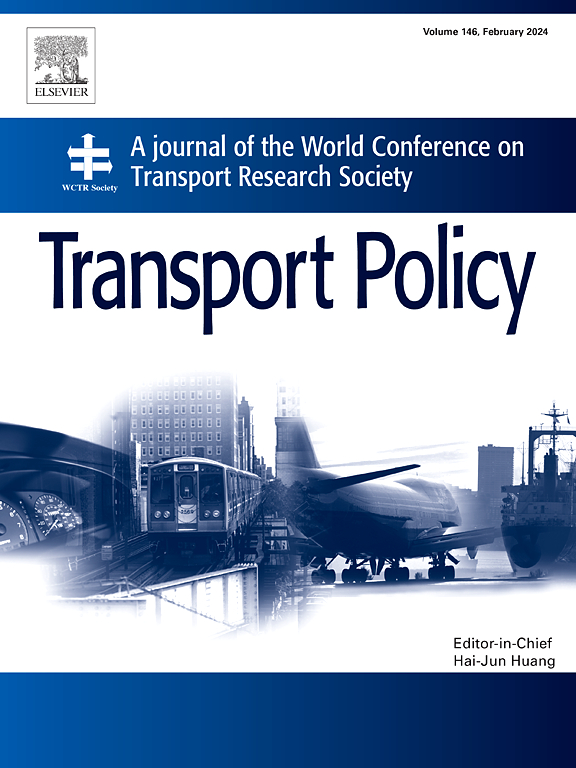A model for speed and fuel refueling strategy of methanol dual-fuel liners with emission control areas
IF 6.3
2区 工程技术
Q1 ECONOMICS
引用次数: 0
Abstract
Methanol dual-fuel (DF) liners can simultaneously use traditional fuel oil and methanol as blended fuels, which can address environmental protection requirements while ensuring economy. This paper presents an optimization model for the speed and refueling strategy of methanol DF liners. A decision-making tool is introduced for shipping companies to develop liner operation plans. A mixed-integer 0–1 planning model is constructed with the objective of minimizing the operating cost of a single voyage of a methanol DF liner, and the optimal solutions for the voyage speed in each segment and the fuel oil and methanol refueling strategy at each port are computed considering the dual-fuel mixing of fuel oil and methanol. In this paper, the validity of the model and algorithm are verified with the AEU3 route of COSCO Shipping as an example, and the results show that installing a scrubber on liners and mixing heavy fuel oil (HFO) and methanol is more economical than mixing very low-sulfur fuel oil (VLSFO) and methanol, considering the existing emission standards. The studied liner should increase its speed in emission control areas (ECAs) and refuel at ports with low prices for fuel oil and methanol. Although the above conclusions are not influenced by changes in the price of methanol, the price difference between HFO and VLSFO, or the carbon allowance price, changes in sulfur emission standards will have a significant effect on the speed and refueling strategy of liners and carbon emissions. This paper provides a theoretical reference for operational decision-making for shipping companies operating methanol DF liners and is of practical value for improving the scientific management of methanol DF liners, enhancing the energy efficiency of ships, and reducing the emission of pollutants from ships.
带排放控制区的甲醇双燃料衬垫的速度和燃料加注策略模型
甲醇双燃料(DF)衬垫可同时使用传统燃油和甲醇作为混合燃料,既能满足环保要求,又能确保经济性。本文介绍了甲醇双燃料班轮航速和加油策略的优化模型。为航运公司制定班轮运营计划介绍了一种决策工具。以甲醇双燃料班轮单航次运营成本最小化为目标,构建了一个混合整数 0-1 规划模型,并考虑到燃油和甲醇的双燃料混合,计算了各航段航速的最优解以及各港口的燃油和甲醇加油策略。本文以中远航运的 AEU3 航线为例,验证了模型和算法的有效性,结果表明,考虑到现有的排放标准,在班轮上安装洗涤器并混合重燃油(HFO)和甲醇比混合极低硫燃油(VLSFO)和甲醇更经济。所研究的班轮应在排放控制区(ECAs)提高速度,并在燃油和甲醇价格低廉的港口加油。虽然上述结论不受甲醇价格变化、重油和轻油价格差异或碳配额价格的影响,但硫排放标准的变化将对班轮的航速和加油策略以及碳排放产生重大影响。本文为经营甲醇双燃料班轮的航运公司提供了运营决策的理论参考,对提高甲醇双燃料班轮的科学管理水平、提高船舶能效、减少船舶污染物排放具有实用价值。
本文章由计算机程序翻译,如有差异,请以英文原文为准。
求助全文
约1分钟内获得全文
求助全文
来源期刊

Transport Policy
Multiple-
CiteScore
12.10
自引率
10.30%
发文量
282
期刊介绍:
Transport Policy is an international journal aimed at bridging the gap between theory and practice in transport. Its subject areas reflect the concerns of policymakers in government, industry, voluntary organisations and the public at large, providing independent, original and rigorous analysis to understand how policy decisions have been taken, monitor their effects, and suggest how they may be improved. The journal treats the transport sector comprehensively, and in the context of other sectors including energy, housing, industry and planning. All modes are covered: land, sea and air; road and rail; public and private; motorised and non-motorised; passenger and freight.
 求助内容:
求助内容: 应助结果提醒方式:
应助结果提醒方式:


